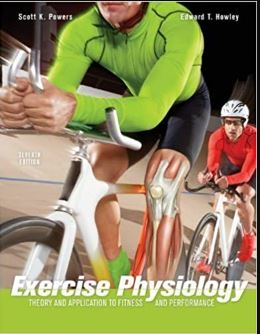Textbook Solution | Exercise Physiology: Theory and Application to Fitness and Performance 7th Edition by Scott Powers

Exercise Physiology: Theory and Application to Fitness and Performance
Exercise Physiology: Theory and Application to Fitness and Performance
Edition 7
Author(s): Scott Powers
ISBN: 978-0071280785
Publisher: Mcgraw hill
501 Explanations
12,072 students have unlocked this book
Textbook Solution | Exercise Physiology: Theory and Application to Fitness and Performance 7th Edition by Scott Powers
Exercise 1 Exercise 2 Exercise 3 Exercise 4 Exercise 5 Exercise 6 Exercise 7 Exercise 8 Exercise 9 Exercise 10 Exercise 11 Exercise 12 Exercise 13 Exercise 14 Exercise 15 Exercise 16 Exercise 17 Exercise 18 Exercise 19 Exercise 20 Exercise 21 Exercise 22 Exercise 23 Exercise 24 Exercise 25 Exercise 26 Exercise 27 Exercise 28
Exercise 1 Exercise 2 Exercise 3 Exercise 4 Exercise 5 Exercise 6 Exercise 7 Exercise 8 Exercise 9 Exercise 10 Exercise 11 Exercise 12 Exercise 13 Exercise 14 Exercise 15 Exercise 16 Exercise 17 Exercise 18 Exercise 19 Exercise 20 Exercise 21 Exercise 22 Exercise 23 Exercise 24 Exercise 25 Exercise 26 Exercise 27 Exercise 28 Exercise 29 Exercise 30 Exercise 31 Exercise 32 Exercise 33 Exercise 34 Exercise 35 Exercise 36 Exercise 37 Exercise 38 Exercise 39 Exercise 40 Exercise 41 Exercise 42 Exercise 43 Exercise 44 Exercise 45 Exercise 46 Exercise 47
Exercise 1 Exercise 2 Exercise 3 Exercise 4 Exercise 5 Exercise 6 Exercise 7 Exercise 8 Exercise 9 Exercise 10 Exercise 11 Exercise 12 Exercise 13 Exercise 14 Exercise 15 Exercise 16 Exercise 17 Exercise 18 Exercise 19 Exercise 20 Exercise 21 Exercise 22 Exercise 23 Exercise 24 Exercise 25 Exercise 26 Exercise 27
Exercise 1 Exercise 2 Exercise 3 Exercise 4 Exercise 5 Exercise 6 Exercise 7 Exercise 8 Exercise 9 Exercise 10 Exercise 11 Exercise 12 Exercise 13 Exercise 14 Exercise 15 Exercise 16 Exercise 17 Exercise 18 Exercise 19 Exercise 20 Exercise 21 Exercise 22 Exercise 23 Exercise 24 Exercise 25 Exercise 26 Exercise 27 Exercise 28 Exercise 29 Exercise 30 Exercise 31 Exercise 32 Exercise 33 Exercise 34 Exercise 35 Exercise 36
Chapter 1: Health, Fitness, and Performance
Free
Chapter 2: Health Risk Appraisal
Chapter 3: Functional Anatomy and Biomechanics
Chapter 4: Exercise Physiology
Chapter 5: Nutrition
Chapter 6: Measurements of Energy Cost in Physical Activity
Chapter 7: Assessment of Cardiorespiratory Fitness
Chapter 8: Assessment of Body Composition
Chapter 9: Assessment of Muscular Fitness
Chapter 10: Assessment of Flexibility and Low-Back Function
Chapter 11: Exercise Prescription for Cardiorespiratory Fitness
Chapter 12: Exercise Prescription for Weight Management
Chapter 13: Exercise Prescription for Muscular Fitness
Chapter 14: Exercise Prescription for Flexibility and Low-Back Function
Chapter 15: Training for Performance
Chapter 16: Exercise for Children and Youth
Chapter 17: Exercise and Older Adults
Chapter 18: Exercise and Womens Health
Chapter 19: Exercise and Heart Disease
Chapter 20: Exercise and Obesity
Chapter 21: Exercise and Diabetes
Chapter 22: Exercise and Pulmonary Disease
Chapter 23: Behavior Change
Chapter 24: Ecg and Exercise Performance
Chapter 25: Injury Prevention and Treatment
Exercise Physiology: Theory and Application to Fitness and Performance 7th Edition by Scott Powers


